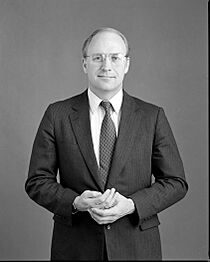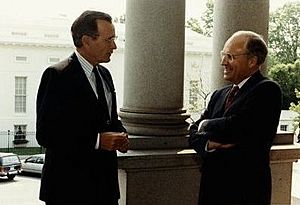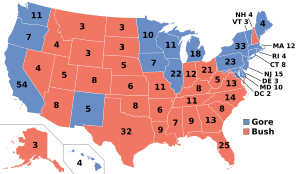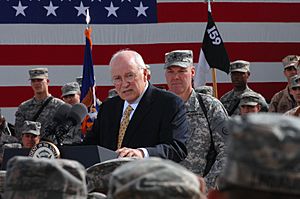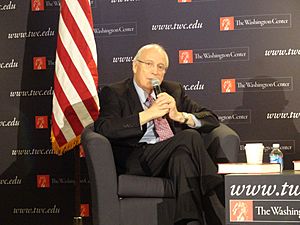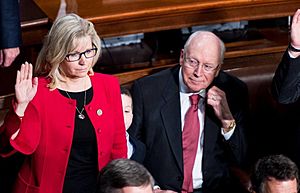Dick Cheney facts for kids
Quick facts for kids
Dick Cheney
|
|
|---|---|
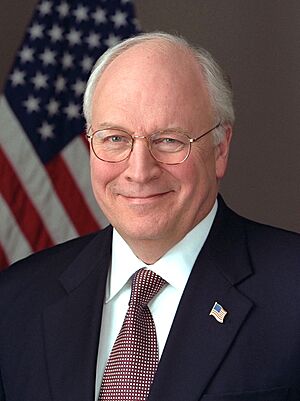
Official portrait, 2003
|
|
| 46th Vice President of the United States | |
| In office January 20, 2001 – January 20, 2009 |
|
| President | George W. Bush |
| Preceded by | Al Gore |
| Succeeded by | Joe Biden |
| 17th United States Secretary of Defense | |
| In office March 21, 1989 – January 20, 1993 |
|
| President | George H. W. Bush |
| Deputy | Donald J. Atwood Jr. |
| Preceded by | Frank Carlucci |
| Succeeded by | Les Aspin |
| House Minority Whip | |
| In office January 3, 1989 – March 20, 1989 |
|
| Leader | Robert H. Michel |
| Preceded by | Trent Lott |
| Succeeded by | Newt Gingrich |
| Chair of the House Republican Conference | |
| In office June 4, 1987 – January 3, 1989 |
|
| Leader | Robert H. Michel |
| Preceded by | Jack Kemp |
| Succeeded by | Jerry Lewis |
| Chair of the House Republican Policy Committee | |
| In office January 3, 1981 – June 4, 1987 |
|
| Leader | Robert H. Michel |
| Preceded by | Bud Shuster |
| Succeeded by | Jerry Lewis |
| Member of the U.S. House of Representatives from Wyoming's at-large district |
|
| In office January 3, 1979 – March 20, 1989 |
|
| Preceded by | Teno Roncalio |
| Succeeded by | Craig L. Thomas |
| 7th White House Chief of Staff | |
| In office November 21, 1975 – January 20, 1977 |
|
| President | Gerald Ford |
| Preceded by | Donald Rumsfeld |
| Succeeded by | Hamilton Jordan (1979) |
| White House Deputy Chief of Staff | |
| In office December 18, 1974 – November 21, 1975 |
|
| President | Gerald Ford |
| Preceded by | Position established |
| Succeeded by | Landon Butler |
| Personal details | |
| Born |
Richard Bruce Cheney
January 30, 1941 Lincoln, Nebraska, U.S. |
| Died | November 3, 2025 (aged 84) |
| Political party | Republican |
| Spouse | |
| Children | |
| Education |
|
| Signature |  |
Richard Bruce Cheney (born January 30, 1941; died November 3, 2025), known as Dick Cheney, was an American politician and businessman. He served as the 46th vice president of the United States from 2001 to 2009 under President George W. Bush. Many people consider him to be one of the most powerful and influential vice presidents in American history.
Before becoming vice president, Cheney had a long career in government. He was the White House Chief of Staff for President Gerald Ford, a member of the U.S. House of Representatives for Wyoming, and the Secretary of Defense for President George H. W. Bush. As Secretary of Defense, he oversaw the U.S. military during the Persian Gulf War. He was also a strong supporter of the Iraq War in 2003.
Contents
Early Life and Education
Richard Bruce Cheney was born in Lincoln, Nebraska, on January 30, 1941. His family later moved to Casper, Wyoming, where he grew up. His father worked for the U.S. Department of Agriculture, and his mother was a talented softball player.
After high school, Cheney attended Yale University but left after a few years. He returned to college at the University of Wyoming, where he earned both a bachelor's and a master's degree in political science. In 1964, he married his high school sweetheart, Lynne Vincent.
Political Career Begins
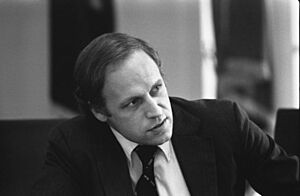
Cheney's career in politics started in 1969 when he worked as an intern for a congressman in Washington, D.C. He quickly moved up and held several jobs in the administrations of President Richard Nixon and President Gerald Ford.
White House Chief of Staff
In 1975, President Ford appointed Cheney as the White House Chief of Staff. This is a very important job, as the chief of staff helps manage the president's schedule and staff, and gives advice on important decisions. At only 34 years old, Cheney was one of the youngest people to ever hold this position.
Member of Congress
After his time in the White House, Cheney returned to Wyoming. In 1978, he was elected to the U.S. House of Representatives, where he represented his home state for ten years. His fellow Republicans in Congress respected him, and he became a party leader.
Secretary of Defense
In 1989, President George H. W. Bush chose Cheney to be his Secretary of Defense. In this role, Cheney was in charge of all branches of the U.S. military. He led the Pentagon during a time of major world changes, including the end of the Cold War.
Cheney oversaw two major military operations. The first was in 1989 in Panama, called Operation Just Cause. The second was a much larger conflict in the Middle East.
The Persian Gulf War
In 1990, the country of Iraq, led by Saddam Hussein, invaded its smaller neighbor, Kuwait. The United States and many other countries formed a coalition to force the Iraqi army out of Kuwait. This conflict became known as the Persian Gulf War.
Cheney, along with General Colin Powell, planned and directed the military operation called Operation Desert Storm. The operation began in January 1991 with air attacks, followed by a ground invasion. The war was a success, and Kuwait was freed in just a few weeks. For his leadership, President Bush awarded Cheney the Presidential Medal of Freedom.
Business Career
After President Bush left office in 1993, Cheney entered the private sector. From 1995 to 2000, he was the chairman and CEO of Halliburton, a large company that provides services to the oil and gas industry.
Vice Presidency (2001–2009)
In 2000, Texas Governor George W. Bush was running for president and asked Cheney to be his vice presidential running mate. They won the close and controversial 2000 election. They were reelected for a second term in 2004.
As vice president, Cheney was deeply involved in all major decisions of the Bush administration. He was known for having more influence than most vice presidents before him.
September 11th and the War on Terror

On September 11, 2001, terrorists attacked the United States. After the attacks, Cheney played a key role in shaping the administration's response. This response was called the "War on Terror."
He was a strong voice in the administration for taking tough actions to protect the country and prevent future attacks. For security reasons, he often worked from secret, protected locations after the attacks.
The Iraq War
Cheney was a leading supporter of the Iraq War, which began in 2003. He and other officials in the Bush administration argued that Iraq's leader, Saddam Hussein, had dangerous weapons, known as weapons of mass destruction, and that he was a threat to the world.
After the U.S. and its allies invaded Iraq, no such weapons were found. The war became very controversial, but Cheney continued to defend the decision to invade, saying it made the world safer.
Life After the White House
After leaving office in 2009, Cheney remained active in public life. He often appeared on television to discuss politics and national security.
Political Views and Books
Cheney wrote a memoir about his life and career called In My Time, which was published in 2011. He also co-wrote another book about foreign policy with his daughter Liz, called Exceptional: Why the World Needs a Powerful America.
He was known for his conservative views but surprised some people in 2009 when he said he supported same-sex marriage.
Critic of Donald Trump
In his later years, Cheney became a strong critic of former President Donald Trump. He was very supportive of his daughter, Liz Cheney, who was a congresswoman from Wyoming and a leading Republican critic of Trump.
In a campaign ad for his daughter in 2022, Cheney called Trump a "threat to our republic." In 2024, he announced that he would vote for the Democratic nominee, Kamala Harris, in the presidential election, saying it was important to put the country before political parties.
Personal Life
Cheney was married to Lynne Cheney for over 60 years. They had two daughters, Liz and Mary Cheney, and seven grandchildren.
Cheney had a history of heart problems, beginning with his first heart attack at age 37. Over the years, he had several heart procedures. In 2012, he received a full heart transplant.
Death
Dick Cheney died on the evening of November 3, 2025, at the age of 84. His death was related to complications from pneumonia and vascular disease.
See also
 In Spanish: Dick Cheney para niños
In Spanish: Dick Cheney para niños


